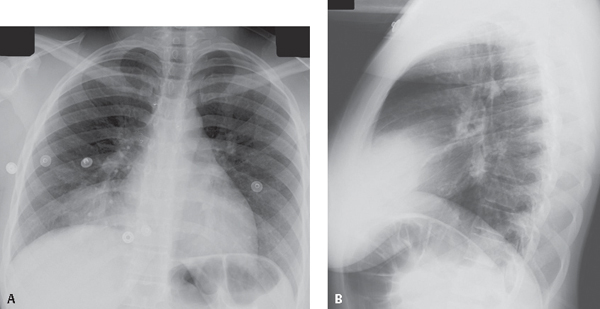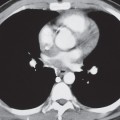CASE 58 19-year-old woman with AIDS, employed as an equestrian trainer, with a CD4 count of 140 cells/μL presenting with fever, cough, increasing fatigue, and chest pain PA (Fig. 58.1A) and lateral (Fig. 58.1B) chest radiographs show focal region of lobar consolidation in the right middle lobe. Note the absence of appreciable volume loss, air bronchograms, and pleural effusion. Rhodococcus equi Pneumonia • Other Community-Acquired and Opportunistic Infections • M. tuberculosis • Various Fungal Infections • Primary and Secondary Lung Neoplasia Fig. 58.1 Rhodococcus equi primarily causes zoonotic infections in grazing animals, namely horses and foals. Although R. equi rarely infects immunocompetent humans, it is emerging as an important pathogen in immunocompromised persons, especially those with AIDS and a CD4 count <200 cells/mm3. Human infection results from inhalation of contaminated aerosols. R. equi is an aerobic, Gram-positive or Gram-variable, weakly acid-fast coccobacillus. It is found worldwide in the soil and in feces of some animals, especially horses. Thirty percent of infected persons have a history of animal exposure, particularly to horses. Eighty to 90% of patients with R. equi infection are immunocompromised. Approximately 50–60% of these patients are HIV-positive, 15–20% have lymphoma, leukemia, or other underlying malignancies, and 10% are transplant recipients. Symptoms in immunocompetent patients are similar to those in immunocompromised patients. Necrotizing pneumonia is the most common pulmonary manifestation of infection. Affected patients have fever and cough (>80%). Fatigue, chest pain, dyspnea, hemoptysis, and weight loss may also occur. Extrapulmonary manifestations of R. equi infection include abscesses (e.g., soft tissues, brain, retroperitoneum), meningitis, pericarditis, endophthalmitis, lymphadenitis, osteomyelitis, septic arthritis, etc. R. equi infections occur in all age groups, with a mean age of 34–38 years. Risk factors for infection in immunocompetent patients include chronic renal insufficiency, alcoholism, and diabetes. Approximately 50% of R. equi infections in immunocompetent patients are due to trauma. Although the diagnosis of R. equi
 Clinical Presentation
Clinical Presentation
 Radiologic Findings
Radiologic Findings
 Diagnosis
Diagnosis
 Differential Diagnosis
Differential Diagnosis

 Discussion
Discussion
Background
Etiology
Clinical Findings
![]()
Stay updated, free articles. Join our Telegram channel

Full access? Get Clinical Tree






